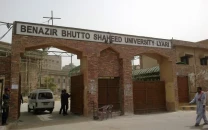True blood: ‘Nucleic acid testing can tell the good blood from the bad - safely’
The new test can pick even the smallest and the most recent infection in blood.

In a country where barely one per cent of the population voluntarily donates blood, a grave number of challenges are faced over the quality of blood transfused.
The assistant professor for the department of pathology and microbiology at Aga Khan University Hospital (AKUH), Dr Bushra Moiz, highlights some concerns. “Most blood banks are hospital-based with no proper system of motivating people to voluntarily donate blood. They include 170 public and 450 private blood banks.”
Acquiring safe blood requires continuous recruitment and retention of the limited pool of voluntary donors. The Sindh Blood Transfusion Authority of Pakistan began a registration process of transfusion services in 1997 and registered 146 blood banks, while 126 were closed as they were sub-optimally managed, she says.
Issues such as a lack of motivation, no verbal screening, the cost of screening kits, periodic unavailability of reagents and inadequately trained personnel compromise the provision of safe blood.
According to Omair Sana Foundation’s Dr Rahat Hussain, the country’s annual demand for blood totals about one million bags. He suggests that if every healthy person commits to donating blood on their birthday every year, it would go a long way in narrowing the demand-supply gap.
Research reveals that the practice also helps the donor stay healthy as they manage to get tested for many diseases at least two to three times a year.
So why are blood donations so important? “There is high incidence of viral hepatitis in the population which is estimated to be between three and four per cent. However, the incidence of HIV [in blood donors] remains low.”
How to procure safe blood?
Dr Moiz describes AKU’s procedure. “There are three steps: verbal scanning, serological testing and the recently included nucleic acid test. Strict donor selection criteria are followed. The individuals are selected through a mini-examination and an interview to determine their health condition. When a healthy blood donor is chosen, (s)he is allowed to donate.”
This blood is then quarantined in a separate refrigerator till the results of the serological testing are available and the blood bank personnel consider it safe for transfusion.
Dr Hussain, meanwhile, estimates that every donation saves three lives as the blood is separated into three components — red cells, platelets and plasma — and used accordingly.
About safety, Dr Moiz says, “As people in Pakistan have comfortably familiarised themselves with deoxyribonucleic acid or DNA testing, the day will soon come when nucleic acid testing (NAT) will be the only safe method to test blood.”
Starting June 14, the AKUH blood bank will be offering NAT. The test, which was first used by the American Red Cross in March 1999, is able to detect very minute amounts of genetic material from deadly viruses such as HIV and hepatitis B and C. In other methods of testing, Moiz claims there is a 20 to 25 per cent chance of “missing the detection of the virus. It is almost as bad as not screening it at all.”
For the blood donor it means the early detection and treatment. Blood banks around the city and the country can benefit as AKUH would be offering NAT testing services in a laboratory.
Published in The Express Tribune, June 14th, 2011.



















COMMENTS
Comments are moderated and generally will be posted if they are on-topic and not abusive.
For more information, please see our Comments FAQ